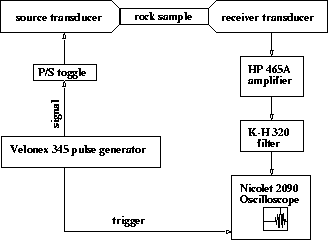




Next: PROCEDURE AND DATA
Up: Lumley et al.: Lab
Previous: INTRODUCTION
We made measurements for a
stainless-steel plug, a dry core and a water-saturated core of Massillon
Sandstone. The water saturation was achieved by a vacuum imbibition
procedure, whereas the dry sample was oven-baked and then measured at standard
room conditions.
The porosity of the sandstone was measured in a pressure vessel by gas
compressibility to be = 22.1%, and had a bulk dry
density of = 2030 kg/m3.
Figure ![[*]](http://sepwww.stanford.edu/latex2html/cross_ref_motif.gif) displays the experimental lab setup.
A high voltage pulse generator (Velonex Model 345) was used to transmit
waves through the given rock samples. We used a pulse width of about
90 nsec, and pulse amplitude of about 500 Volts. The pulse could be
toggled between ¶ and §-modes. The rock sample was held in place in a
table-top clamp apparatus. Natural honey was used
to couple the rock samples to the source and receiver
transducers. A force gauge measured the 100 lb compression which was
applied to the
rock sample end surface areas by a manual press in a clamping mechanism.
displays the experimental lab setup.
A high voltage pulse generator (Velonex Model 345) was used to transmit
waves through the given rock samples. We used a pulse width of about
90 nsec, and pulse amplitude of about 500 Volts. The pulse could be
toggled between ¶ and §-modes. The rock sample was held in place in a
table-top clamp apparatus. Natural honey was used
to couple the rock samples to the source and receiver
transducers. A force gauge measured the 100 lb compression which was
applied to the
rock sample end surface areas by a manual press in a clamping mechanism.
A transmitted pulse is carried from the clamp apparatus to a
Nicolet Model 2090 oscilloscope for waveform display. Along the way, the
pulse is passed through a 20/40 dB linear amplifier (HP 465A), and an
analog filter device (K-H Model 320) for bandpass filtering. We used
a bandpass range of 1.5-100 kHz. The waveforms could be stored on the
oscilloscope and then written to a floppy diskette.
Setup
Figure 1 Experimental lab setup.






Next: PROCEDURE AND DATA
Up: Lumley et al.: Lab
Previous: INTRODUCTION
Stanford Exploration Project
11/18/1997
![[*]](http://sepwww.stanford.edu/latex2html/cross_ref_motif.gif) displays the experimental lab setup.
A high voltage pulse generator (Velonex Model 345) was used to transmit
waves through the given rock samples. We used a pulse width of about
90 nsec, and pulse amplitude of about 500 Volts. The pulse could be
toggled between ¶ and §-modes. The rock sample was held in place in a
table-top clamp apparatus. Natural honey was used
to couple the rock samples to the source and receiver
transducers. A force gauge measured the 100 lb compression which was
applied to the
rock sample end surface areas by a manual press in a clamping mechanism.
displays the experimental lab setup.
A high voltage pulse generator (Velonex Model 345) was used to transmit
waves through the given rock samples. We used a pulse width of about
90 nsec, and pulse amplitude of about 500 Volts. The pulse could be
toggled between ¶ and §-modes. The rock sample was held in place in a
table-top clamp apparatus. Natural honey was used
to couple the rock samples to the source and receiver
transducers. A force gauge measured the 100 lb compression which was
applied to the
rock sample end surface areas by a manual press in a clamping mechanism.
